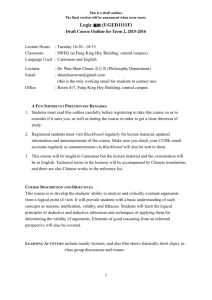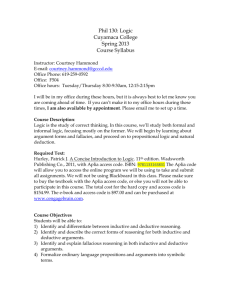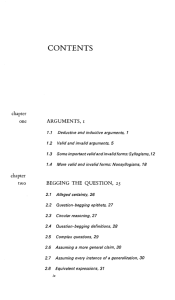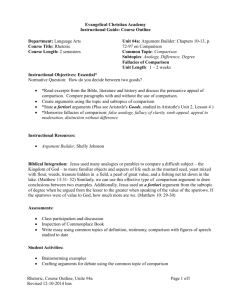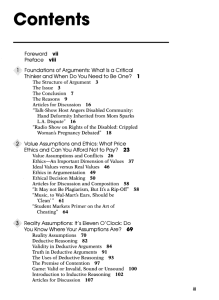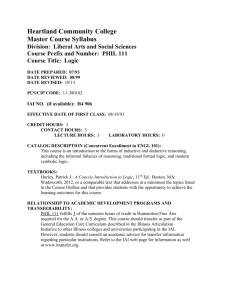outline, logic, 1415a (draft)
advertisement
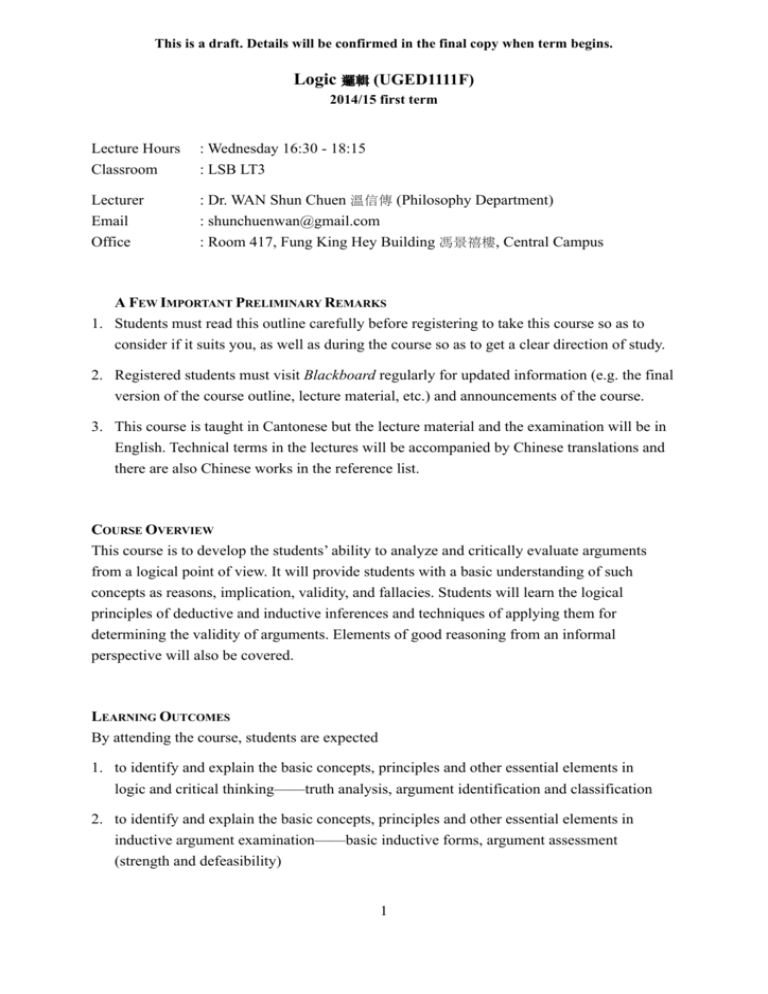
This is a draft. Details will be confirmed in the final copy when term begins. Logic 邏輯 (UGED1111F) 2014/15 first term Lecture Hours Classroom : Wednesday 16:30 - 18:15 : LSB LT3 Lecturer Email Office : Dr. WAN Shun Chuen 溫信傳 (Philosophy Department) : shunchuenwan@gmail.com : Room 417, Fung King Hey Building 馮景禧樓, Central Campus A FEW IMPORTANT PRELIMINARY REMARKS 1. Students must read this outline carefully before registering to take this course so as to consider if it suits you, as well as during the course so as to get a clear direction of study. 2. Registered students must visit Blackboard regularly for updated information (e.g. the final version of the course outline, lecture material, etc.) and announcements of the course. 3. This course is taught in Cantonese but the lecture material and the examination will be in English. Technical terms in the lectures will be accompanied by Chinese translations and there are also Chinese works in the reference list. COURSE OVERVIEW This course is to develop the students’ ability to analyze and critically evaluate arguments from a logical point of view. It will provide students with a basic understanding of such concepts as reasons, implication, validity, and fallacies. Students will learn the logical principles of deductive and inductive inferences and techniques of applying them for determining the validity of arguments. Elements of good reasoning from an informal perspective will also be covered. LEARNING OUTCOMES By attending the course, students are expected 1. to identify and explain the basic concepts, principles and other essential elements in logic and critical thinking——truth analysis, argument identification and classification 2. to identify and explain the basic concepts, principles and other essential elements in inductive argument examination——basic inductive forms, argument assessment (strength and defeasibility) 1 This is a draft. Details will be confirmed in the final copy when term begins. 3. to identify and explain the basic concepts, principles and other essential elements in deductive argument examination——basic deductive forms, argument assessment (validity and soundness) 4. to analyze how an argument goes wrong——formal and informal fallacy analysis; LEARNING ACTIVITIES include mainly lectures, tutorials, short video chips, in-class group discussions and exams. COURSE SYLLABUS 1. Introduction * what logic is and why it is important 2. To think in a proper way (I): some basic techniques this section relates chiefly to Learning Outcomes 1 and 4 * the basic parts of an argument(論證) * two kinds of truth and their respective characteristics * arguments go wrong: fallacies(謬誤) * how pitfalls of language is involved in fallacies: ambiguity, vagueness, distortion, etc. * two common forms of argument: induction(歸納法)and deduction(演繹法) 3. To think in a proper way (II): inductive arguments this section relates chiefly to Learning Outcome 2 * to assess the goodness of induction: inductive force, “high” probability and defeasibility (可修正性) * to use real life examples in demonstrating the aforesaid concepts and principles 4. To think in a proper way (II): deductive arguments this section relates chiefly to Learning Outcome 3 * to assess the goodness of deduction: validity(有效)and soundness(對確) * basic rules, symbolizing techniques and proofs in sentential logic * square of opposition, syllogism, Venn diagrams in syllogistic logic 2 This is a draft. Details will be confirmed in the final copy when term begins. COURSE SCHEDULE Date Topic/Activities References Hurley (2012) Sept 3 Introduction 1.1 Sept 10 Basics of Logic I 1.2, 1.3, 1.4, 1.5 Sept 17 Basics of Logic II 2.1, 2.2, 2.3 Sept 24 Induction I 9.1 Oct 1 Public Holiday (NO CLASS) Oct 8 Induction II 10.1 Oct 15 Induction III 10.2 Oct 22 Deduction I 5.1, 5.2, 5.3 Oct 29 IN-CLASS EXAM 1 (See Assessment Below) with lecture after the exam 4.1, 4.5, 4.6 Nov 5 Deduction II 6.1, 6.2, 6.3 Nov 12 Deduction III 6.4, 6.6 Nov 19 IN-CLASS EXAM 2 (See Assessment Below) Nov 26 Essay Analysis GENERAL REFERENCES The following is a PRELIMINARY listing of books you may wish to consult throughout the course. And all of them are available in our library. I must emphasize that they are NOT textbooks for this course. And more specific readings of chapter length will be assigned during the lectures and such instructions will be available on Blackboard. Hurley, J. P. (2012) A Concise Introduction to Logic, 11th edition, Boston, MA: Wadsworth. This is the edition I use commonly. It is a standard textbook good enough for a 2-term logic course. It contains detailed explanation of technical terms and rules, and lots of examples, exercises and suggested answers. You may not be able to get the most updated edition and 3 This is a draft. Details will be confirmed in the final copy when term begins. earlier editions are perfectly acceptable. Some copies, probably older editions, are already reserved in our libraries. As a general reference, Hurley (2012) is certainly resourceful. Yet it is over 700 pages and covers much more than we will discuss. The following two are much shorter, thus more easily accessible. Weston, A. (2009) Rulebook for Arguments, 4th/edn, Hackett Publishing Company. (early editions are also acceptable) This one is non-technical and really short (under 100 pages) and I highly recommend it as a kind of introduction. While the next one is also short but targets more advanced readers. Priest, G. (2001) Logic: A Very Short Introduction, New York: Oxford University Press. You may also consult the followings that contain more detailed explanations, examples and exercises. When I don’t specify the year of publication, it means that any edition will be all right. • Copi, I. and Cohen, C. Introduction to Logic, Prentice Hall. (like Hurley (2012) also with lots of examples, exercises and suggested answers) • Salmon, W. C. Logic, N.J.: Englewood Cliffs. (the digital version of the 1984 edition is available here: http://www.ditext.com/salmon/logic.html)(《邏輯》何秀煌譯,臺北:三 民書局。)(this one is shorter than Hurley and Copi, but no exercise) For Chinese readings, I recommend the following. · 陳波(2002)《邏輯學是什麼》,北京:北京大學出版社。 · 方子華等(2005)《批判思考》,McGraw-Hill Education (Asia)。 · 李天命(1981)《語理分析的思考方法》,香港:青年書屋。 SUGGESTED READINGS FOR SOME MAJOR TOPICS The readings are optional. They are useful in the sense that they provide more detailed explanations, examples and exercises related to the lecture topics. A. Meaning and Truth 1. 李天命(1981)《語理分析的思考方法》,第三篇〈語言的陷阱〉 ,頁 37-72。 2. Hurley (2012) A Concise Introduction to Logic 2.1 Varieties of Meanings and 2.2 The Intension and Extension of Terms 3. Salmon (1984) Logic, Section 4 “Logic and language,” especially chs. 31 “Use and Mention,” 32 “Definitions,” 33 “Analytic, Synthetic, and Contradictory Statements,” and 35 “Ambiguity and Equivocation” (NOTE: this work is available on the Internet, see above) 4 This is a draft. Details will be confirmed in the final copy when term begins. B. Arguments 1. 陳波(2002)《邏輯學是什麼》,第六章〈歸納邏輯〉,頁 162-200。 2. Hurley (2012) A Concise Introduction to Logic 1.1 Arguments, Premises and Conclusions, 1.2 Recognizing Arguments, 1.3 Deduction and Induction and 1.4 Validity, Truth, Soundness, Strength, Cogency 3. Salmon (1984) Logic Ch. 4 “Deductive and Inductive Arguments,” Ch. 19 “Inductive Correctness,” Ch. 20 “Induction by Enumeration,” and Ch. 28 “Mill's Methods” C. Categorical Syllogism 1. Hurley (2012) A Concise Introduction to Logic 5.1 [Categorical Syllogism’s] Standard Form, Mood, and figure, 5.2 Venn Diagrams, 5.3 Rules and Fallacies, 4.1 The Components of Categorical Propositions, 4.5 The Traditional Square of Opposition, 4.6 Venn Diagrams and the Traditional Standpoint 2. Salmon (1984) Logic Ch. 13 “Categorical statements,” Ch. 14 “Categorical Syllogisms” and Ch. 15 “Venn Diagrams and Class Logic” D. Fallacy Analysis 1. 楊國榮:〈謬誤〉,收於方子華等(2005)《批判思考》第四章,頁 57-84。 2. Weston, A. (2009) Rulebook for Arguments, 4th/edn, Appendix I “Some Common Fallacies,” pp. 73-9. 3. Hurley (2012) A Concise Introduction to Logic Chapter 3 “Informal Fallacies” I will also assign more readings upon specific topics and such instructions will be available on Blackboard. Moreover, you are most welcome to have a word with me anytime if you want to explore further than what I have suggested. And you could contact me via email (see above) or in person (preferably with an appointment first). 5 This is a draft. Details will be confirmed in the final copy when term begins. ASSESSMENT METHODS AND EXPLANATION Type of assessment Score In-class Exam 1 40 (to be held on Oct 29 in class, starts by 16:30) In-class Exam 2 60 (to be held on Nov 19 in class, starts by 16:30) Total 100 1. There will be no make-up exam for those who miss any of these assessments. 2. If the day of any exam is affected by bad weather or accidents, it will be POSTPONED to the following week, that is Nov 5 (for Exam 1) or Nov 26 (for Exam 2), location and time remain unchanged. • • SOME EXPLANATION ON THE ASSESSMENT METHODS: Both in-class exams consist of any of the following: multiple choice questions, true/false questions and/or problem solving short questions (not essay type). The exams assess chiefly the students’ understanding of basic concepts, principles and other essential elements of logic, as well as to their capability to apply the skills learnt in all the sections of the syllabus. Questions will set with different levels of difficulties, on various topics taught throughout the course. The questions here aim at assessing the students’ combined capabilities learned in all the sections of the syllabus. Both the in-class exams are conducted in English and closed-books. For both in-class exams, students are allowed to bring an A4 sized cheat-sheet (both sides, hand-written or print). ACADEMIC HONESTY AND PLAGIARISM Although no assignment in essay form is required in this course, I would still like to draw your attention to the University policy and regulations on honesty in academic work, and to the disciplinary guidelines and procedures applicable to breaches of such policy and regulations. Details may be found at http://www.cuhk.edu.hk/policy/academichonesty/ 6
